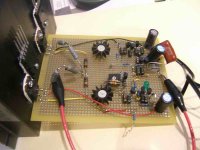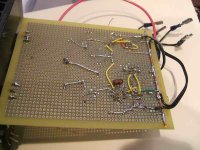Hello to Everyone !
I would be very interested to know if:
1) a breadboard is still the best tool to build a prototype 🙄
2) the quality of a stereo amp schema can be assessed just building one channel. 😕
Actually my intention would be to mix the L and R signals at the input and using just one speaker to test and optimize it.
It is the first time that I try to convert a schema in a prototype, so I am very confused and unexperienced. 🙁
Building just one channel a time seems to me a much simpler approach then making all the two channels.
If the prototype channel will work then I will build another one completely identical.
Suggestions will be very much appreciated. 😱
Thank you very much and kind regards, 🙂
gino
I would be very interested to know if:
1) a breadboard is still the best tool to build a prototype 🙄
2) the quality of a stereo amp schema can be assessed just building one channel. 😕
Actually my intention would be to mix the L and R signals at the input and using just one speaker to test and optimize it.
It is the first time that I try to convert a schema in a prototype, so I am very confused and unexperienced. 🙁
Building just one channel a time seems to me a much simpler approach then making all the two channels.
If the prototype channel will work then I will build another one completely identical.
Suggestions will be very much appreciated. 😱
Thank you very much and kind regards, 🙂
gino
Last edited:
I get along well with veroboard or stripboard.
If one amp sounds great then I cant think of a reason why it shouldnt sound good in a stereo pair.
If one amp sounds great then I cant think of a reason why it shouldnt sound good in a stereo pair.
I get along well with veroboard or stripboard..
Thank you very much indeed for your kind and helpful reply
I understand that with these boards soldering is needed
Nebertheless I have read of some issues like bad contacts with breadboards
After all soldering is much more reliable connection
If one amp sounds great then I cant think of a reason why it shouldnt sound good in a stereo pair
I think the same as you, I am a strong believer in dual mono construction
By the way I saw a lot of very good preamp and amp where the two channels are identical either they were in the same chassis or not.
I will take some veroboards then.
Thanks a lot again
Kind regards,
gino
Are you referring to the "old school" breadboarding technique of screws & dish washers holding down all the connections?
I've done this in the past and it works. If you use soft wood its harder to get a reliable contact than with a harder wood. Also, this technique makes all the leads really long and so parasitic inductance and capacitance can become a problem at HF if you're not careful.
And then there's the rats nest of wires with low impedance, high voltage supplies on them. If you've never shorted out a 50,000uF cap charged to 40V before - it's quite an event.
P.S. building one channel first is definitely recommended. You learn so much on the first one - building one first saves time in the long run.
I've done this in the past and it works. If you use soft wood its harder to get a reliable contact than with a harder wood. Also, this technique makes all the leads really long and so parasitic inductance and capacitance can become a problem at HF if you're not careful.
And then there's the rats nest of wires with low impedance, high voltage supplies on them. If you've never shorted out a 50,000uF cap charged to 40V before - it's quite an event.
P.S. building one channel first is definitely recommended. You learn so much on the first one - building one first saves time in the long run.
It may not be critical for AF designs, but for RF there are techniques like "ugly" or "dead bug" and "Manhattan" that use a plain PCB as a ground plane.
Manhattan" style PCB Construction
Manhattan" style PCB Construction
Last edited:
Are you referring to the "old school" breadboarding technique of screws & dish washers holding down all the connections? I've done this in the past and it works. If you use soft wood its harder to get a reliable contact than with a harder wood
Good evening !
I am referring to something like this one
http://www.robotroom.com/Joystick/Breadboard.jpg
There are clips to make contacts
Also, this technique makes all the leads really long and so parasitic inductance and capacitance can become a problem at HF if you're not careful.
And then there's the rats nest of wires with low impedance, high voltage supplies on them.
If you've never shorted out a 50,000uF cap charged to 40V before - it's quite an event
To be more precise I intend to experiment a solid state line stage
60V single supply rails ... 470uF of capacitance max on the board
A very simple line stage
P.S. building one channel first is definitely recommended.
You learn so much on the first one - building one first saves time in the long run
Thank you very much for your kind and valuable advice.
Honestly I thought it were much easier, just two bjts per channel ...
I should pass to a only one bjt per channel ... if only I found a suitable schematic ...
Thanks again and kind regards,
gino
Like Nigel Wright, here's how I do it.
Very nice work !
I am very beginner nevertheless the idea of implementing a project is very exciting to me
It would be the first time I make something
I modded some amps in the past, with debatable results
Kind regards,
gino
- Status
- Not open for further replies.
- Home
- Design & Build
- Construction Tips
- Working with breadboards

